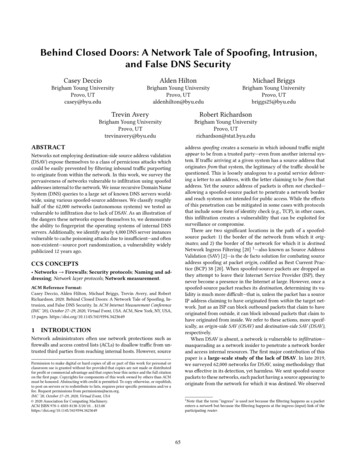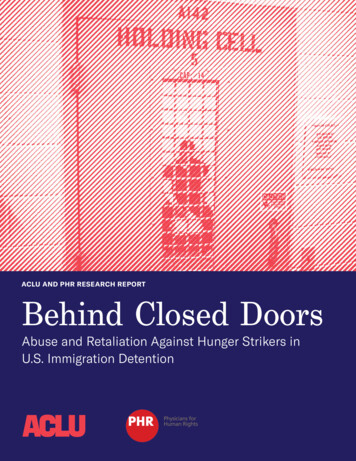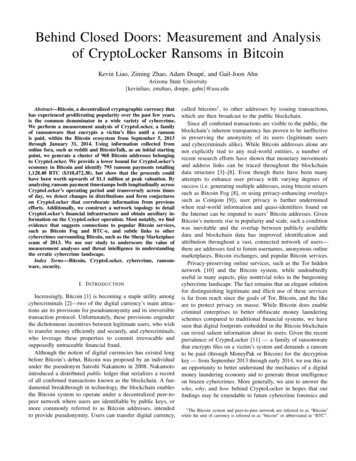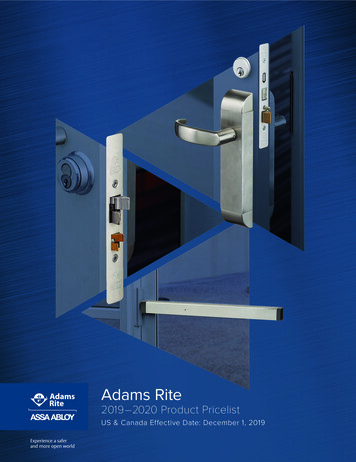
Transcription
Behind Closed Doors: A Network Tale of Spoofing, Intrusion,and False DNS SecurityCasey DeccioBrigham Young UniversityProvo, UTcasey@byu.eduAlden HiltonBrigham Young UniversityProvo, UTaldenhilton@byu.eduTrevin AveryRobert RichardsonBrigham Young UniversityProvo, UTtrevinavery@byu.eduBrigham Young UniversityProvo, UTrichardson@stat.byu.eduABSTRACTaddress spoo ng creates a scenario in which inbound tra c mightappear to be from a trusted party—even from another internal system. If tra c arriving at a given system has a source address thatoriginates from that system, the legitimacy of the tra c should bequestioned. This is loosely analogous to a postal service delivering a letter to an address, with the letter claiming to be from thataddress. Yet the source address of packets is often not checked—allowing a spoofed-source packet to penetrate a network borderand reach systems not intended for public access. While the e ectsof this penetration can be mitigated in some cases with protocolsthat include some form of identity check (e.g., TCP), in other cases,this in ltration creates a vulnerability that can be exploited forsurveillance or compromise.There are two signi cant locations in the path of a spoofedsource packet: 1) the border of the network from which it originates; and 2) the border of the network for which it is destined.Network Ingress Filtering [20] 1 —also known as Source AddressValidation (SAV) [2]—is the de facto solution for combating sourceaddress spoo ng at packet origin, codi ed as Best Current Practice (BCP) 38 [20]. When spoofed-source packets are dropped asthey attempt to leave their Internet Service Provider (ISP), theynever become a presence in the Internet at large. However, once aspoofed-source packet reaches its destination, determining its validity is much more di cult—that is, unless the packet has a sourceIP address claiming to have originated from within the target network. Just as an ISP can block outbound packets that claim to haveoriginated from outside, it can block inbound packets that claim tohave originated from inside. We refer to these actions, more specifically, as origin-side SAV (OSAV) and destination-side SAV (DSAV),respectively.When DSAV is absent, a network is vulnerable to in ltration—masquerading as a network insider to penetrate a network borderand access internal resources. The rst major contribution of thispaper is a large-scale study of the lack of DSAV. In late 2019,we surveyed 62,000 networks for DSAV, using methodology thatwas e ective in its detection, yet harmless. We sent spoofed-sourcepackets to these networks, each packet having a source appearing tooriginate from the network for which it was destined. We observedNetworks not employing destination-side source address validation(DSAV) expose themselves to a class of pernicious attacks whichcould be easily prevented by ltering inbound tra c purportingto originate from within the network. In this work, we survey thepervasiveness of networks vulnerable to in ltration using spoofedaddresses internal to the network. We issue recursive Domain NameSystem (DNS) queries to a large set of known DNS servers worldwide, using various spoofed-source addresses. We classify roughlyhalf of the 62,000 networks (autonomous systems) we tested asvulnerable to in ltration due to lack of DSAV. As an illustration ofthe dangers these networks expose themselves to, we demonstratethe ability to ngerprint the operating systems of internal DNSservers. Additionally, we identify nearly 4,000 DNS server instancesvulnerable to cache poisoning attacks due to insu cient—and oftennon-existent—source port randomization, a vulnerability widelypublicized 12 years ago.CCS CONCEPTS Networks ! Firewalls; Security protocols; Naming and addressing; Network layer protocols; Network measurement.ACM Reference Format:Casey Deccio, Alden Hilton, Michael Briggs, Trevin Avery, and RobertRichardson. 2020. Behind Closed Doors: A Network Tale of Spoo ng, Intrusion, and False DNS Security. In ACM Internet Measurement Conference(IMC ’20), October 27–29, 2020, Virtual Event, USA. ACM, New York, NY, USA,13 pages. https://doi.org/10.1145/3419394.34236491Michael BriggsBrigham Young UniversityProvo, UTbriggs25@byu.eduINTRODUCTIONNetwork administrators often use network protections such as rewalls and access control lists (ACLs) to disallow tra c from untrusted third parties from reaching internal hosts. However, sourcePermission to make digital or hard copies of all or part of this work for personal orclassroom use is granted without fee provided that copies are not made or distributedfor pro t or commercial advantage and that copies bear this notice and the full citationon the rst page. Copyrights for components of this work owned by others than ACMmust be honored. Abstracting with credit is permitted. To copy otherwise, or republish,to post on servers or to redistribute to lists, requires prior speci c permission and/or afee. Request permissions from permissions@acm.org.IMC ’20, October 27–29, 2020, Virtual Event, USA 2020 Association for Computing Machinery.ACM ISBN 978-1-4503-8138-3/20/10. . . 15.00https://doi.org/10.1145/3419394.34236491 Notethat the term “ingress” is used not because the ltering happens as a packetenters a network but because the ltering happens at the ingress (input) link of theparticipating router.65
IMC ’20, October 27–29, 2020, Virtual Event, USACasey Deccio, Alden Hilton, Michael Briggs, Trevin Avery, and Robert Richardsonthat about half of the networks we surveyed lacked DSAV, allowingour spoofed-source packets into their network.Even more important than the fact that a network can be in ltrated is the impact of the unauthorized access—how it might beexploited to survey or compromise internal systems. The second major contribution of this paper is an analysis of internal systemsreached via network in ltration, as a case study motivating theimportance of DSAV. We characterize and assess the vulnerabilityof systems accessed through experimental spoofed-source packets.We accomplished this by issuing spoofed-source Domain Name System (DNS) queries to almost 12 million DNS servers. These queriesreached about 5% of targets, allowing us to survey over a half millionservers. Within the target networks lacking DSAV, we identi ednearly 4,000 DNS servers that were vulnerable to cache poisoningattack, 59% of which would have been protected had DSAV been inplace. While untested as part of this work, networks lacking DSAValso expose otherwise unreachable—and possibly vulnerable—DNSresolvers to other attacks such as DNS zone poisoning [29] and therecently disclosed NXNS attack [43].2to originate from the client’s network are sent to each client. Ifthe client receives the spoofed packet, Spoofer is able to infer thelack of DSAV. Researchers recently reported a surprising 67% and74% of the IPv4 and IPv6 autonomous systems (ASes) measured,respectively, lacking DSAV [32].Our approach addresses two limitations associated with Spoofer’sDSAV measurement. First, a signi cant portion of the Spooferclients are run behind Network Address Translation (NAT) gateways, for which DSAV cannot be tested (i.e., because the clienthas no public IP address from which it can be reached). Secondly,Spoofer requires a user to opt in to the study by downloading andrunning the client. Our methodology only targets public IP addresses on existing infrastructure, such that no client software isrequired.In work performed concurrently with (and independently of)our own, Korczyński, et al. [30], tested networks for source addressvalidation using a methodology similar to ours. They issued queriesto every IP address in the IPv4 space, in each case spoo ng thesource IP address just higher than the selected destination. In contrast, our objectives focused on exploring the variety of ways inwhich a lack of DSAV might be discovered. Our methodology di ersprimarily in that 1) we use as many as 101 diverse, spoofed-sourceIP addresses for each destination, rather than only the next sequential IP address; 2) the selection of target IP addresses used in ourresearch consist of those that generate query activity at the rootservers; and 3) our study includes both IPv4 and IPv6. Our resultsshow that there are advantages to both the current methodologyand that used by Korczyński, et al. In particular, the sheer breadthof the IPv4 address space scanned by Korczyński, et al., resultedin more overall hits than our targeted approach. The diversity ofspoofed sources used in our experiment uncovered resolvers—andASes—that would not have otherwise been identi ed using only asame-pre x source. We discuss this further in Section 4.1. Nonetheless, the overall percentage of measured ASes with reachable IPv4targets is consistent between the two studies, within 1%: 48.78%vs. 49.34%. Finally, in the current paper, we extend our analysis tosurvey and identify vulnerabilities of internal systems, as a casestudy of our methodology.Related to our vulnerability analysis of internal DNS resolvers,Sche er, et al. [42], analyzed internal DNS recursive servers usinga di erent technique. By communicating over the Simple MailTransfer Protocol (SMTP) with servers that performed Sender PolicyFramework (SPF) [28] validation, they were able to elicit queriesof the mail servers’ recursive DNS servers. Their results turned upvery little evidence of servers lacking source port randomization,whereas our study shows a non-trivial number—nearly 4,000 DNSresolvers with invariant source ports.BACKGROUND AND PREVIOUS WORKBCP 38 [20] urges ISPs to deploy OSAV to prevent packets withspoofed sources from leaving their networks. This containmentprevents these networks from being contributors to spoo ng-basedattacks, such as re ection and intrusion. In a re ection attack, anattacker spoofs the address of a victim in the request to a server,and the server sends its response to the victim, typically in anothernetwork. Network intrusion occurs when a network with no OSAVsends a spoofed-source packet to a network with no DSAV, and thepacket’s source matches IP pre xes originated by its target network.In this case, packets enter a network with a spoofed source thatappears to have originated from within the destination network.The internal system receiving the spoofed-source packets will seethem as having originated internally.Spoo ng-based re ection and intrusion must be carried out withan application-layer protocol, such as the DNS. The DNS is a queryresponse protocol used for translating domain names to Internet resources, such as IP addresses. Stub resolvers query recursive resolvers(or servers), which nd an answer by querying authoritative servers.While authoritative DNS servers are typically open to queries fromany Internet entity, recursive servers are traditionally closed, onlyallowing queries from known clients [10]. Open recursive serversexist, but are discouraged (although public DNS services are becoming more prevalent [8, 22, 23, 39, 45]). For this reason, authoritativeDNS services and open recursive DNS services are more likely tobe used in re ection, whereas closed resolvers are the more likelytarget for intrusion.In the area of DNS-based re ection attacks, researchers haveexplored both attack potential [44] and the deployment of DNSResponse Rate Limiting (RRL) [12, 33, 34, 46].With regard to SAV measurement, the Spoofer Project has beeninvolved in measuring SAV for over 10 years [2, 5, 32]. Spoofer datacomes from participants who voluntarily install and run the Spooferclient on their machines. This client’s primary role is to send outspoofed-source probes to test for OSAV. However, it also playsa part in DSAV measurement. Spoofed-source packets appearing3EXPERIMENT SETUPOur DSAV experiment consisted of sending DNS queries withspoofed-source IP addresses to millions of recursive DNS serversworld-wide. Our goal was to determine whether or not each queryreached its target DNS server, and thus penetrated the network border in the process. Having no observable presence at the addresseswe spoofed, we had no way of assessing reachability by examiningresponses. Thus, we determined that a recursive DNS server was66
Behind Closed DoorsIMC ’20, October 27–29, 2020, Virtual Event, USA Same pre x: an IP address from the same /24 (IPv4) or /64(IPv6) pre x. Private or unique local: 192.168.0.10 or fc00::10. Destination-as-source: the target IP address itself. Loopback: 127.0.0.1 or ::1.Network Border1ClientLogDataAuthoritativeDNS ServersSpoofed-SourceDNS QueryryQue2 DNSseponResDNSDNS RecursiveResolverDNSResponse4The other-pre x addresses were generated as follows. We rstlooked up the AS number (ASN) for every target IP address. Foreach ASN in the resulting set, we looked up all the IP pre xesoriginating from that AS. The next steps depended on whether theIP address and ASN were associated with IPv4 or IPv6.For IPv4, we divided all the IP address space originating froman AS into 24-bit pre xes. Every /24 pre x containing a targetIP address was set aside for random selection of a same-pre x IPaddress. From each of the remaining /24 pre xes, we selected, atrandom, a single IP address. In both cases, the rst and the last IPaddresses were excluded from selection because of their reservedstatus in a /24 subnet. The resulting IP addresses formed the setof other-pre x addresses for any target IP address announced bythat AS. Because some ASes had a prohibitively large number of/24 pre xes, we limited our selection to 97 pre xes2 .For IPv6, we similarly divided each AS’s aggregate IP addressspace, but we used a 64-bit pre x, which is the typical pre x lengthfor IPv6 subnets. As with IPv4, we selected an IP address from withineach /64 pre x announced by the AS—for both the same-pre x andother-pre x addresses. However, we used a more targeted methodology to identify more realistic client addresses, rather than blindlyprobing the sparsely-populated IPv6 address space. First, for IPv6pre x selection, we gave preference to /64 pre xes that containedIPv6 addresses from an IPv6 “hit list” [21]—a sign of observed activity within that pre x. Second, address selection within a /64 pre xwas limited to the rst 100 addresses in the /64 pre x (minus the rst two addresses, often used for the router address).3Figure 1: Experiment setup, in which (1) a client sends a DNSquery with spoofed source to an internal DNS recursive resolver, (2) the recursive resolver issues a query to our DNSauthoritative servers, (3) the authoritative server responds,and (4) a DNS response is issued by the DNS recursive server.reachable if, for a given query, we observed a corresponding queryat a DNS authoritative server—an indicator of the recursive server’sattempt to resolve the query name. The query names used in ourexperiment were such that 1) no query name would ever be foundin the cache of a DNS resolver and 2) the servers authoritative for allqueries are under our control (see Section 3.3). Figure 1 illustratesour setup.3.1DNS Servers (Targets)To generate a set of target IP addresses, we used the “Day in theLife” (DITL) [16] data, sponsored by the DNS Operations, Analysis,and Research Center (OARC) [17]. The DITL data consists of 48hours of DNS queries destined for the DNS root servers, contributedby members of the DNS operator community, including operatorsof the DNS root servers [41]. Thus, it provides a rich source ofpotential recursive DNS servers for our experiment. We extractedthe source IP addresses from the DNS queries captured in the 2019DITL collection (April 2019).Not all of the source IP addresses extracted from the DITL datawere acceptable targets for our experiment. We excluded about4 million addresses designated as “special purpose” addresses byIANA [9]; for these addresses, there would be no legitimate entries in public routing table. We excluded another 36,027 sourceIP addresses for which there was no announced route from whichwe could derive other-pre x addresses from the same AS (see Section 3.2). Ultimately, our set of target IP addresses consisted of11,204,889 IPv4 addresses and 784,777 IPv6 addresses, from 53,922and 7,904 ASes, respectively.3.23.3Query NamesWe encoded the query names used in our experiment according tothe following template: ts.src.dst.asn.kw.dns-lab.org, where tsis the timestamp the query was sent, src is the spoofed-source IPaddress, dst is the target IP address, asn is the ASN of the target IPaddress, and kw is a keyword associated with the current experiment. With this template, we could associate any query arriving atthe dns-lab.org authoritative servers (under our control) with theexperimental query that induced it. The use of a timestamp in thequery name ensured the uniqueness of a given query such that itwould never be in the cache of a recursive resolver.Our primary interest was whether a query with one of the experimental query names reached our authoritative DNS servers.We did not see any particular bene t to making the experimentalquery names actually resolve. Therefore, to simplify our setup, ourauthoritative servers returned an NXDOMAIN (name does not exist)response code in response to any experimental queries. When analyzing our data, however, we learned that there were some sidee ects associated with this approach that caused some gaps in ourSpoofed SourcesThe set of source addresses for each target was selected with theintent of maximizing the chances that the target would accept aquery. If the server rejected a query, we could not systematicallyknow if that query had penetrated a network border. For any giventarget IP address, we issued as many as 101 DNS queries usingspoofed sources from the following categories:2 Thenumber 97 was chosen when we had three other spoofed-source categories inmind, such that the maximum number of source IP addresses we would use for a giventarget would be an even 100. However, we ended up adding another source IP addressto our experiment, such that at most 101 sources would be used to query a given target. Other pre x: up to 97 other-pre x addresses (explained hereafter).67
IMC ’20, October 27–29, 2020, Virtual Event, USACasey Deccio, Alden Hilton, Michael Briggs, Trevin Avery, and Robert Richardsonexperiment visibility. We discuss these side e ects and quantifytheir impact on our analysis in Section 3.6.4.3.4ASes, at least one recursive-to-authoritative query was receiveddirectly from an address in the target AS. In these cases, evenif our spoofed-source query did not reach its destination IP address, we know that reached its destination AS, which con rmedlack of DSAV. As for the remaining ASes, at least one recursive-toauthoritative query was received from major public DNS services(Cloud are [23], Google [22], CenturyLink [7], OpenDNS [8], orQuad9 [39]) for 89% of IPv4 ASes and 86% of IPv6 ASes. Forwardingto such DNS services is not characteristic of middleboxes. Thesenumbers explain all but 2% (IPv4) and 1% (IPv6) for our per-ASDSAV measurements.Query ExecutionThe queries were scheduled such that the entire experiment wouldbe carried out in about four weeks time. Considering the number oftarget IP addresses and the sources for each, the rate of DNS queriesleaving our client maintained a rate of roughly 700 queries persecond—which was an administrative constraint we were requiredto work with. We spaced the queries for a given target IP addresssuch that they were evenly spread over the entire duration of theexperiment.The queries associated with our experiment were issued betweenNovember 6 and December 27, 2019, from a network that lackedOSAV (BCP 38 [20]). The absence of OSAV in our client’s networkwas a requirement for e ectively testing DSAV. The time frame forour experiment was longer than the four weeks we had plannedbecause of several unexpected interruptions, including a poweroutage. Despite the gaps in our experimental activity, we were ableto successfully issue all of the prepared queries associated with theexperiment, albeit behind schedule.3.53.6.2 Data Freshness. We consider the reasonableness of usingDITL as a set of target recursive IP addresses. Certainly not all ofthe approximately 12 million target IP addresses from the DITL datawere functioning as recursive servers at the time of our experiment.It is possible that some IP addresses that did represent recursiveDNS servers at the time of DITL collection, no longer did when weran our experiment six months later. Previous research has shownthat there is churn in IP addresses of DNS resolvers—speci cally,open resolvers—over time [31]. It is also possible that some of theIP addresses might never have been used used as recursive DNSservers. For example, perhaps they represent software used onlyto monitor Internet connectivity or health. We argue that we areworking with an incomplete but su ciently representative data set.This is validated in part by the fact our results are consistent withthose from previous work (see Section 2). Additionally, we do notexpect our data to include the IP addresses of all recursive servers.This is in part because the DITL data is not comprehensive (i.e., notall root servers participate in the collection) and in part becausean active resolver might not need to query the root server duringthat period, depending on its query patterns and caching behaviors.Finally, the source IP address of some of the queries captured in theDITL data might in fact be spoofed and thus not associated withan actual DNS resolver.There is also the question of whether or not IP churn occurringduring the experiment itself a ected the results, causing addressesthat were at one point responsive to be unresponsive later on. Whilethis situation is certainly possible, it could really only a ect theresults of one aspect of our study, that of spoofed-source e ectiveness (Section 4.1); for the rest of our evaluation of DSAV, anAS was considered to be lacking DSAV if at least one query washandled by a target IP address. We might have chosen to send allqueries to a given target IP address in rapid succession, rather thanspreading them out over the entire experiment period; this wouldhave mitigated the question of churn. However, we opted to minimize possible impact and attention, e.g., from IDS, by spreadingthe queries out.Follow-Up QueriesWe monitored authoritative DNS server logs to detect incomingqueries that had been generated as a result of our activity, in realtime. Whenever we rst observed a DNS query associated with agiven target IP address, a series of follow-up queries were issued tothat target IP address. The follow-up queries were sent using thesame spoofed-source address as that which induced the query rstobserved at our authoritative servers. Subsequent queries associatedwith the target IP address (i.e., beyond the rst) were logged butnot further acted on; thus, a given target IP address only receivedone set of follow-up queries. The follow-up queries included: IPv4- and IPv6-only: two sets of 10 queries that elicited queriesexclusively over IPv4 and IPv6, respectively, to our authoritative servers. Open resolver: non-spoofed-source query. TCP: a query that elicited a DNS-over-TCP query to ourauthoritative servers.The IPv4- and IPv6-only queries were elicited by using query namesin DNS domains that were only delegated to IPv4 addresses or IPv6addresses, respectively. The TCP query was elicited by issuing aquery for which the authoritative server would always respondwith the truncation (TC) bit set. A truncated response causes therecursive resolver to issue its query again over TCP [13].3.6Methodology Considerations3.6.3 Human Intervention. We expect that some of our spoofedsource queries might be dropped and/or logged by IDS or serversas suspicious. Curious human analysts might resolve the domainname to learn more about the activity, resulting in a query to ourauthoritative servers. However, such a query does not providereliable DSAV information.To overcome this ambiguity, we calculated query lifetime (i.e.,how long it was “alive” in the system) by subtracting the timestampembedded in the query name from the time at which the query wasSeveral issues merit our discussion, including the e ect of middleboxes or human intervention on our experiment, data freshness,and QNAME minimization.3.6.1 Middleboxes. It is possible for a DNS request to be transparently intercepted and handled by a middlebox between our clientand the target DNS resolver [6]. In this case it would be unclearif the DNS resolver itself—or, more importantly, its network—wasreachable. We observed that for 86% of IPv4 ASes and 95% of IPv668
Behind Closed DoorsIMC ’20, October 27–29, 2020, Virtual Event, USAreceived at our authoritative servers. We considered a query witha lifetime of 10 seconds or less as unlikely made by a human, inresponse to logs. While a query passing through the most reliablesystems might consistently have a lifetime of less than a singlesecond, we selected this higher threshold because query retransmissions (i.e., by recursive resolvers) can happen after timeouts ofone or more seconds. The results we present only include querieswhose lifetime was under our 10-second threshold. Queries for anadditional 3,444 IPv4 addresses and 70 IPv6 addresses had a lifetime that exceeded our threshold, representing less than 0.1% ofaddresses, for both protocols. These corresponded to 421 IPv4 ASesand 32 IPv6 ASes. For all but 19 and 2 of these ASes, we were able toinfer lack of DSAV through the presence of other resolvers whichdid query our servers within the 10 second window.key guidelines for ethical research in this area. Of the ethics principles outlined in the Menlo Report, those most applicable to ourcurrent research are 1) justice, 2) respect for law and public interest,and 3) bene cence.Regarding justice, our measurements considered all target IPaddresses (i.e., from the DITL data) equally; no particular industry,geography, nation state, address space, or protocol was deliberatelytargeted more than another.Perhaps the biggest ethical question associated with our researchwas the legality of measuring another’s network using our methodology. Our measurements crossed interstate boundaries world-wide,each potentially with their own laws regarding unauthorized network access. For example, the United States (U.S.) outlaws anyintentional access of non-public, government-owned computer systems, without authorization [24]. We cannot de nitively determinewhether or not the systems that we measured are non-public norwhether our benign packets even constitute a violation of thisstatute. In any case, we believe that our methodology is justi edbecause of the bene t it brings in the public interest. Indeed theMenlo Report’s principle of bene cence suggests that the bene tsof an experiment should be maximized and the harms minimized.Bringing to light the severity and pervasiveness of the lack of DSAVand the potential for network penetration is extremely valuable tothe Internet community. We expect that responsibly publishing our ndings will be a catalyst in spreading awareness and taking thenecessary action to ll the security gaps identi ed herein.The potential harms associated with our experiment might include degradation of service due to our tra c, time spent followingup on alerts from Intrusion Detection Systems (IDS), or carelessvulnerability disclosure. We took several measures to minimize anynegative impact, and even the appearance of abuse. First, we limitedboth the number and the rate of queries directed towards any givendestination, as described in Section 3.4. Considering query ratesat production DNS servers are typically measured in queries persecond, and our maximum per-destination rate was on the orderof four per day—plus a one-time series of fewer than 30 follow-upqueries—the impact of our experiment would have been barely,if at all, noticeable. Second, the SOA (start of authority) record ofthe DNS zone corresponding to our query names (see Section 3.3)included: 1) a RNAME (responsible name) eld with an email addresswith which we could be contacted, e.g., for more information or toopt out; and 2) an MNAME (master server name) eld with the domainname of a Web sever providing a brief description of this project.The project description included contact and opt-out information.The system from which the queries with non-spoofed sources weresent (see Section 3.5) also ran a Web server with the same projectinformation.3.6.4 QNAME Minimization. In an e ort to preserve privacy, somemodern DNS resolvers avoid sending authoritative servers thefull query name (QNAME) and instead only ask for the next unknown label. This is known as QNAME Minimization [3]. In thecase of our experiment, before asking for the full QNAME (i.e.,ts.src.dst.asn.kw.dns-lab.org), a resolver using QNAME minimization would ask for kw.dns-lab.org, then asn.kw.dns-lab.org,etc. As we mentioned in Section 3.3, our authoritative servers returned an NXDOMAIN response code in response to any queries related to our experiment. For at least some resolver implementationsthat implement QNAME minimization, an NXDOMAIN response haltsfurther queries associated with the QNAME. This is because anNXDOMAIN for a given domain name implies that no subdomains(i.e., with additional labels on the left) exist [4].We observed QNAME-minimized queries from 17,981 (0.16%)of the IP addresses that we targeted with our initial reachabilityquery. For 9,898 (55%) of these IP addresses, we never received aquery with the full QNAME. Most notably, they did not includethe label with the encoded source address. With no way to identifythe source IP address that we used to reach these 9,898 targets, weexluded them from the total number of reachable targets. Nonetheless, we still learned something about the networks from whichthe QNAME-minimized queries originated. We observed that DNSclients from 2,081
Behind Closed Doors IMC '20, October 27-29, 2020, Virtual Event, USA Client DNS Recursive Resolver Spoofed-Source DNS Query Network Border DNS Response









